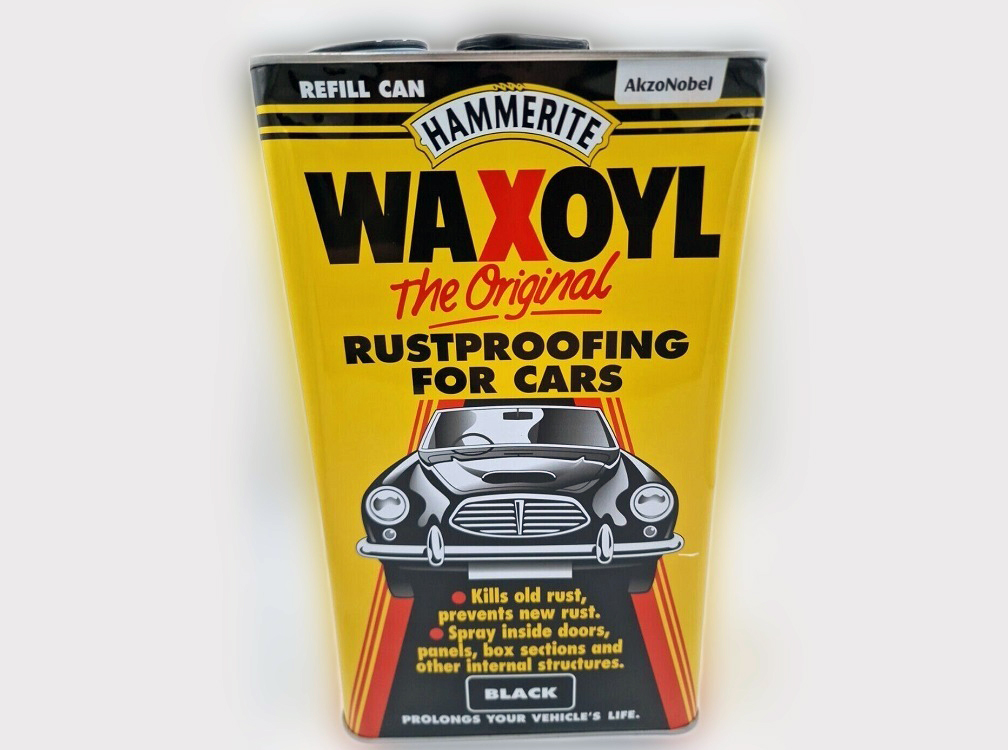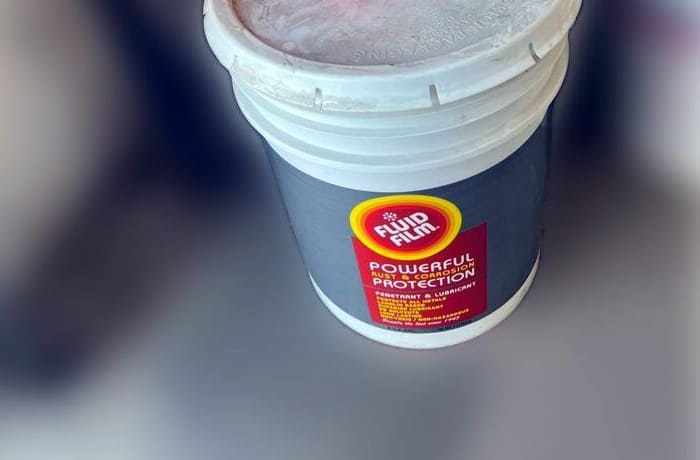Rust can be a car owner’s worst nightmare, significantly shortening a vehicle’s life and impacting its performance. In the battle against corrosion, products like Waxoyl and Fluid Film have become go-to solutions for their protective qualities.
Both products are well-known for their effectiveness but differ significantly in their approach and application. Understanding these differences is crucial for any vehicle owner looking to preserve their investment.

Table of Contents
Waxoyl: A Trusted Name in Corrosion Prevention
Waxoyl has long been a staple in the automotive industry, particularly favored for its thorough protection against rust.
Originating in Switzerland, Waxoyl has built a reputation for extending vehicle life through a robust formulation that seals out moisture and air—two critical elements in rust formation.

Fluid Film: Natural and Effective
On the other hand, Fluid Film offers a slightly different approach to rust prevention. It is well-known for using lanolin (wool wax) as the main ingredient, which is naturally derived and renowned for its ability to repel water.
This product prevents rust and maintains its greasy consistency, helping to continuously protect and lubricate the parts.
1. Formula and Chemical Properties
Understanding the chemical composition of Waxoyl and Fluid Film can give us insight into how these products work to prevent rust and protect your vehicle.
Waxoyl
Key Ingredients and How They Combat Rust
Waxoyl’s formulation is particularly notable for its heavy-duty use of petroleum-based waxes and corrosion inhibitors. These ingredients create a waterproof barrier that effectively seals out the elements contributing to rust.
This barrier prevents moisture penetration and shields against dirt and salt, which are prevalent in causing vehicle corrosion, especially in colder climates.
Long-term Protective Properties
The protective layer formed by Waxoyl is designed to be durable and long-lasting. Once applied, it solidifies to form a tough, tack-free coating that clings to metal surfaces without dripping or sagging.
This makes it particularly effective for protecting vehicle areas prone to prolonged exposure to moisture and road chemicals.
Fluid Film
Key Ingredients and How They Combat Rust
Unlike Waxoyl, Fluid Film utilizes a lanolin-based formula. Lanolin, a natural wax extracted from sheep’s wool, is highly effective at repelling water.
Its inherent properties stop rust and continue penetrating and protecting over time, reaching even the tiniest crevices for comprehensive coverage.
Natural, Lanolin-based Formulation
Fluid Film’s natural composition makes it an environmentally friendly option. It is non-toxic, solvent-free, and contains no heavy metals, making it safe to use repeatedly.
This aspect particularly appeals to those conscious about the environmental impact of the products they use on their vehicles.
2. Application Process
Correctly applying Waxoyl and Fluid Film is essential for ensuring optimal protection against rust for your vehicle.
Each has specific procedures that must be followed to ensure the coating adheres appropriately and offers maximum protection.
Waxoyl
Steps for Surface Preparation and Application
Preparing the surface before applying Waxoyl is essential. The vehicle’s underbody and other areas prone to rust must be clean and dry. Any existing rust should be treated or removed before application.
Waxoyl is typically applied with a spray gun, which allows for an even coating over large areas. It’s essential to heat the product before spraying to ensure it flows smoothly and covers all nooks and crannies effectively.
Best Practices for Comprehensive Vehicle Coverage
For optimum results, Waxoyl should be applied in a well-ventilated area, and protective gear should be worn to avoid inhalation of fumes.
All vulnerable areas must be covered, including wheel arches, seams, and joints where moisture can accumulate. Ensuring these areas are well-coated will extend the protective benefits and durability of the treatment.
Fluid Film
Steps for Surface Preparation and Application
Like Waxoyl, the application area for Fluid Film must be clean and free of any loose rust or dirt. Fluid Film can be applied directly without heating using a spray can or gun.
The product’s natural viscosity allows it to spread and penetrate quickly, even at lower temperatures, making it ideal for quick applications.
Tips for Maintaining Consistent Protection
Fluid Film remains active and does not dry out, providing ongoing protection that can easily be replenished with additional applications.
Regular inspections of treated areas are recommended, especially after harsh weather conditions or exposure to salty environments. Touch-ups are simple—clean the area and reapply.
3. Effectiveness and Durability
The real-world performance of Waxoyl and Fluid Film under varying conditions can reveal a lot about their suitability for long-term vehicle protection.
Here, we examine how each withstands environmental challenges like severe weather and frequent exposure to corrosive elements.
Waxoyl
Performance in Severe Weather and Salt Exposure
Waxoyl is highly regarded for its performance in extreme conditions, particularly in regions with severe winters and high road salt usage.
The product’s robust formula provides a strong barrier that resists salt and moisture penetration. Tests and user reports indicate that Waxoyl can maintain its protective properties for years without needing a reapplication, even in harsh weather.
Durability Over Time with Regular Maintenance
Waxoyl’s protection can last several years with proper application and occasional maintenance. The key to maximizing its durability is ensuring that any chips or damage to the coating are promptly addressed.
Regular checks, especially after the winter season, help to maintain the integrity of the coating and extend the vehicle’s rust-free lifespan.
Fluid Film
Performance in Varying Climatic Conditions
Fluid Film’s natural, lanolin-based formulation excels in various climatic conditions. Its ability to repel water and moisture is practical in humid and dry environments.
The product’s greasy nature allows it to self-heal, which means it can reflow into minor scratches or nicks, continuously protecting and preserving the metal.
Reapplication Frequency and Ease of Maintenance
One of the advantages of Fluid Film is its ease of maintenance. Since it does not harden or dry out, reapplying it is straightforward and can be done as often as needed without extensive surface preparation.
This makes it an excellent choice for regular maintenance, particularly for coastal areas where salt air is prevalent, as frequent touch-ups can significantly prolong the effectiveness of rust protection.
4. Specific Automotive Use Cases
The effectiveness of Waxoyl and Fluid Film extends beyond just general rust prevention; their unique properties make them suitable for specific parts of a vehicle, catering to different needs and conditions. Here’s how each product can be strategically applied to optimize vehicle protection.
Waxoyl
Recommended for Underbody and Chassis Applications
Waxoyl is particularly effective for treating the underbody and chassis of a vehicle. These areas are most susceptible to rust due to constant exposure to road debris, moisture, and chemicals like road salt.
The robust film that Waxoyl creates is ideal for sealing out these elements, providing a durable barrier that guards against corrosion.
Effectiveness in Enclosed Spaces Like Door Cavities
Waxoyl is also highly recommended in enclosed spaces, such as door cavities, boot ledges, and wing edges. These are areas where moisture can collect and stay, creating a prime environment for rust.
Waxoyl’s ability to create a comprehensive coating protects these hard-to-reach areas, reducing the risk of internal rust, which can be difficult and expensive to repair.
Fluid Film
Utility in Undercoating and External Metal Surfaces
Fluid Film shines as an undercoating for vehicles. Its fluid consistency allows it to cover and penetrate easily into all the nooks and crannies of a vehicle’s undercarriage, providing a protective layer that guards against rust.
This property also makes it suitable for external metal surfaces where flexibility and moisture resistance are crucial.
Suitability for Moving Parts and Electrical Connections
One of Fluid Film’s unique advantages is its non-drying, penetrative nature, making it excellent for moving parts like hinges, locks, and electrical connections.
It does not become tacky or gummy, ensuring that parts remain operational and protected from corrosion. This makes it incredibly versatile, not just in protecting against rust but also in maintaining the functionality of various vehicle components.
5. Cost and Overall Value
When deciding on a rust prevention product like Waxoyl or Fluid Film, the cost is an essential factor in terms of initial outlay and long-term value and effectiveness. Here’s a breakdown of the financial aspects of both products to help guide your decision.
Waxoyl
Initial Investment and Coverage Costs
Waxoyl is generally considered a higher initial investment than other rust prevention options. The product and the application process—which may require professional assistance due to the need for specialized equipment like a spray gun and heating tools—add to the upfront costs. However, its extensive coverage means fewer products are needed in a larger area.
Long-term Value Considering Protection Duration
Despite its higher initial cost, Waxoyl’s long-term value is significant. Its durability means reapplications are needed less frequently, sometimes only every few years, depending on the environment and the vehicle’s exposure to corrosive elements.
This extended protection period can make Waxoyl a cost-effective option in the long run, especially for those looking to keep their vehicles in top condition for many years.
Fluid Film
Cost Effectiveness for Annual Applications
Fluid Film offers a more budget-friendly initial cost and is easy to apply. The vehicle owner can do it, reducing the need for professional application costs.
The product can be reapplied easily because it does not dry out, making it suitable for annual maintenance schedules without significant preparation or additional expense.
Long-term Savings from Reduced Corrosion Rates
Regularly applying fluid film can significantly prolong the life of a vehicle by effectively preventing rust. The savings in potential repairs due to rust damage can be substantial, particularly in regions with harsh weather conditions or where road salt is heavily used.
These savings, combined with the product’s lower cost and ease of application, present a compelling value proposition for regular vehicle maintenance.
Conclusion
Choosing between Waxoyl and Fluid Film for automotive rust prevention depends mainly on your needs, budget, and maintenance preferences.
Waxoyl offers a durable, long-term solution with less frequent reapplications, making it a good choice for those who invest more upfront for prolonged protection.
Fluid Film, on the other hand, is more cost-effective and straightforward to apply regularly, which is ideal for vehicle owners looking for a flexible and budget-friendly option.
Both products protect your vehicle from rust, ensuring it remains in excellent condition over the years. Carefully consider your vehicle’s exposure to corrosive elements and how often you can perform maintenance to make the best choice for your rust prevention needs.
